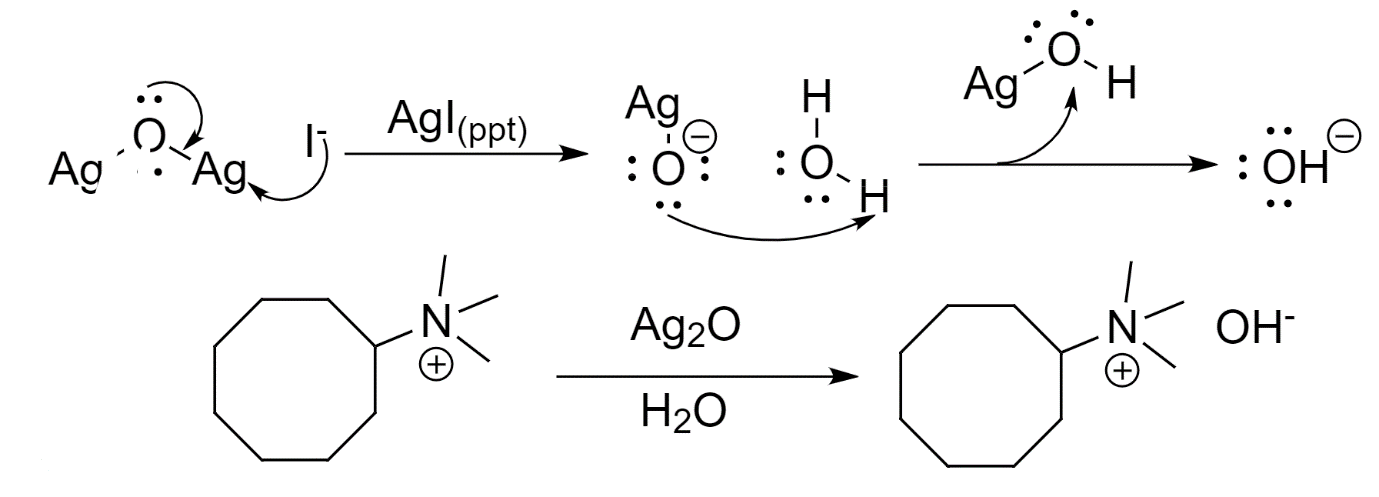
Explain Hoffmann's exhaustive alkylation with examples.
Answer
440.4k+ views
1 likes
Hint: To explain Hoffmann's exhaustive alkylation, we first need to know what is Hoffmann's rule. According to Hoffmann's rule, during elimination reactions, the alkene which is the least substituted will be formed as a major product.
Complete answer:
Hoffmann's rule stated that in eliminating reactions of an amine, the outcome of the product is heavily dependent on the steric effects. Since the least substituted position in an alkane is the least hindered, the loss of
This is why the olefin or the alkene which is the least substituted will be formed as a major product. The product formed is known as Hoffman Product.
Now, when an amine is treated with an excess of an alkyl iodide to form an alkene, the process is known as Hoffman exhaustive alkylation.
The alkyl iodide used in Hoffman exhaustive alkylation is methyl iodide
Let us understand the mechanism of Hoffman exhaustive methylation by taking dimethylcyclooctanamine as the amine which is used to synthesize cyclooctene.
- First, the excess methyl iodide attacks the

- The iodide ion formed is substituted with the hydroxide ion. This is done by reacting silver oxide and iodide and water being deprotonated successively by the ion of silver oxide.

- Finally, to facilitate the elimination reaction, the reaction mixture is heated to obtain cyclooctene.

- Further, trans-cyclooctene can be isolated from the cis-trans mixture of products as follows

Note:
It should be noted that among neutral
Complete answer:
Hoffmann's rule stated that in eliminating reactions of an amine, the outcome of the product is heavily dependent on the steric effects. Since the least substituted position in an alkane is the least hindered, the loss of
This is why the olefin or the alkene which is the least substituted will be formed as a major product. The product formed is known as Hoffman Product.
Now, when an amine is treated with an excess of an alkyl iodide to form an alkene, the process is known as Hoffman exhaustive alkylation.
The alkyl iodide used in Hoffman exhaustive alkylation is methyl iodide
Let us understand the mechanism of Hoffman exhaustive methylation by taking dimethylcyclooctanamine as the amine which is used to synthesize cyclooctene.
- First, the excess methyl iodide attacks the

- The iodide ion formed is substituted with the hydroxide ion. This is done by reacting silver oxide and iodide and water being deprotonated successively by the ion of silver oxide.

- Finally, to facilitate the elimination reaction, the reaction mixture is heated to obtain cyclooctene.

- Further, trans-cyclooctene can be isolated from the cis-trans mixture of products as follows

Note:
It should be noted that among neutral
Latest Vedantu courses for you
Grade 10 | MAHARASHTRABOARD | SCHOOL | English
Vedantu 10 Maharashtra Pro Lite (2025-26)
School Full course for MAHARASHTRABOARD students
₹33,300 per year
Recently Updated Pages
Master Class 9 General Knowledge: Engaging Questions & Answers for Success

Master Class 9 English: Engaging Questions & Answers for Success

Master Class 9 Science: Engaging Questions & Answers for Success

Master Class 9 Social Science: Engaging Questions & Answers for Success

Master Class 9 Maths: Engaging Questions & Answers for Success

Class 9 Question and Answer - Your Ultimate Solutions Guide

Trending doubts
State and prove Bernoullis theorem class 11 physics CBSE

Who built the Grand Trunk Road AChandragupta Maurya class 11 social science CBSE

1 ton equals to A 100 kg B 1000 kg C 10 kg D 10000 class 11 physics CBSE

State the laws of reflection of light

One Metric ton is equal to kg A 10000 B 1000 C 100 class 11 physics CBSE

Difference Between Prokaryotic Cells and Eukaryotic Cells




